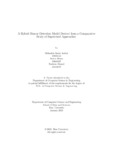| dc.contributor.advisor | Rasel, Mr. Annajiat Alim | |
| dc.contributor.advisor | Choudhury, Ms. Najeefa Nikhat | |
| dc.contributor.author | Aothoi, Mehzabin Sadat | |
| dc.contributor.author | Ahsan, Samin | |
| dc.contributor.author | Ahmed, Fardeen | |
| dc.date.accessioned | 2023-08-29T09:23:11Z | |
| dc.date.available | 2023-08-29T09:23:11Z | |
| dc.date.copyright | 2023 | |
| dc.date.issued | 2023-01 | |
| dc.identifier.other | ID: 19101353 | |
| dc.identifier.other | ID: 19101497 | |
| dc.identifier.other | ID: 22241037 | |
| dc.identifier.uri | http://hdl.handle.net/10361/20156 | |
| dc.description | This thesis is submitted in partial fulfillment of the requirements for the degree of Bachelor of Science in Computer Science and Engineering, 2023. | en_US |
| dc.description | Cataloged from PDF version of thesis. | |
| dc.description | Includes bibliographical references (pages 39-41). | |
| dc.description.abstract | In the current age of social media, information spreads like wildfire. Unfortunately,
this also means that misinformation or rumors can spread easily. The spread of this
misinformation can have negative consequences for society. This is especially true in
recent years due to growing engagement in social media platforms for news. Hence,
to prevent the spread of rumors, rumor detection is necessary. Bangladesh has
been no exception to the spread of misinformation, causing countless propaganda
over the years. Although a significant amount of work has already been conducted
regarding rumor detection in English, Bangla rumor detection is still in its infancy.
For our research, we first compared several Machine Learning (ML) models and Deep
Learning (DL) models for rumor detection using both Bangla and English datasets.
Comparing and analyzing the results, we implemented an Ensemble ML model and
finally our hybrid model, which is a combination of our best-performing ML model
and DL model that outperformed all other baseline state-of-the-art models. | en_US |
| dc.description.statementofresponsibility | Mehzabin Sadat Aothoi | |
| dc.description.statementofresponsibility | Samin Ahsan | |
| dc.description.statementofresponsibility | Fardeen Ahmed | |
| dc.format.extent | 41 pages | |
| dc.language.iso | en | en_US |
| dc.publisher | Brac University | en_US |
| dc.rights | Brac University theses are protected by copyright. They may be viewed from this source for any purpose, but reproduction or distribution in any format is prohibited without written permission. | |
| dc.subject | Rumor detection | en_US |
| dc.subject | NLP | en_US |
| dc.subject | Machine learning | en_US |
| dc.subject | Deep learning | en_US |
| dc.subject | Decision tree | en_US |
| dc.subject | Random forest | en_US |
| dc.subject | Naive bayes | en_US |
| dc.subject | Support Vector Machine (SVM) | en_US |
| dc.subject | BERT | en_US |
| dc.subject | RNN | en_US |
| dc.subject | CNN | en_US |
| dc.subject.lcsh | Artificial intelligence | |
| dc.subject.lcsh | Machine learning | |
| dc.subject.lcsh | Cognitive learning theory | |
| dc.title | A hybrid rumor detection model derived from a comparative study of supervised approaches | en_US |
| dc.type | Thesis | en_US |
| dc.contributor.department | Department of Computer Science and Engineering, Brac University | |
| dc.description.degree | B. Computer Science and Engineering | |

